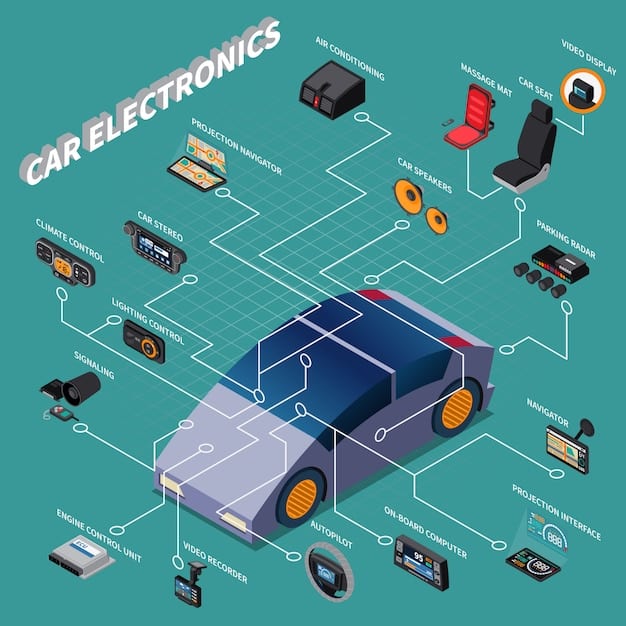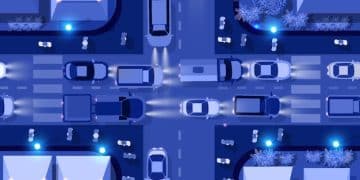5G Expansion & Autonomous Vehicles: US Development by 2026

The expansion of 5G networks across the US is poised to revolutionize the development of autonomous vehicles by 2026, offering enhanced connectivity, reduced latency, and increased data processing capabilities, which are crucial for the safe and efficient operation of self-driving cars.
The race to autonomous vehicles is heavily reliant on the underlying infrastructure that supports them. By 2026, the widespread rollout of 5G networks across the US is expected to significantly affect the progress and capabilities of self-driving cars.
How 5G Technology Enhances Autonomous Vehicle Capabilities
5G technology is more than just faster internet; it’s a foundational element for the future of mobility. Autonomous vehicles require real-time data processing and seamless communication, something that previous generations of mobile networks couldn’t fully deliver. This section explores how 5G addresses these challenges and enables new possibilities for self-driving cars.
Reduced Latency and Real-Time Decision Making
One of the most significant advantages of 5G is its ultra-low latency. This refers to the delay between sending and receiving data, which is crucial for autonomous vehicles that need to react instantly to changing road conditions.
Increased Bandwidth for Data Processing
5G offers substantially higher bandwidth compared to 4G, allowing autonomous vehicles to process massive amounts of data in real-time. This includes data from sensors, cameras, and radar, which is essential for accurate navigation and object detection.
- Enhanced safety through quicker reaction times.
- Improved traffic flow due to real-time data sharing among vehicles.
- Greater efficiency in route planning and navigation.

The convergence of these capabilities creates a safer and more efficient driving experience. 5G’s ability to handle large data volumes with minimal delay is not just an incremental improvement; it’s a game-changer for autonomous vehicle technology, making real-time decision-making a reality.
The Role of 5G in Vehicle-to-Everything (V2X) Communication
Vehicle-to-Everything (V2X) communication is a cornerstone of autonomous driving, enabling vehicles to communicate with other vehicles, infrastructure, and pedestrians. 5G plays a pivotal role in making V2X communication more reliable and efficient.
Vehicle-to-Vehicle (V2V) Communication
V2V communication allows cars to share information about their speed, location, and direction, helping to prevent accidents and improve traffic flow. 5G’s high bandwidth and low latency enable near-instantaneous data exchange between vehicles.
Vehicle-to-Infrastructure (V2I) Communication
V2I communication connects vehicles to roadside infrastructure, such as traffic lights and road sensors. This allows vehicles to receive real-time updates about traffic conditions, construction zones, and other potential hazards.
- Improved road safety through proactive hazard alerts.
- Optimized traffic management and reduced congestion.
- Enhanced navigation and route planning based on real-time conditions.
5G-enabled V2X communication fosters a collaborative driving environment, where vehicles and infrastructure work together to enhance safety and efficiency. This level of connectivity is crucial for achieving full autonomy and unlocking the full potential of self-driving cars.
Challenges in Deploying 5G for Autonomous Vehicles
While 5G offers numerous benefits for autonomous vehicles, its deployment faces several challenges. Overcoming these hurdles is essential for realizing the vision of widespread autonomous driving by 2026.
Infrastructure Development and Coverage
Building out the necessary 5G infrastructure across the US is a massive undertaking. Ensuring consistent and reliable coverage, especially in rural areas, is essential for autonomous vehicles to operate safely and effectively.
Security and Data Privacy
With increased connectivity comes increased vulnerability to cyberattacks. Protecting autonomous vehicles and their data from malicious actors is a critical challenge that requires robust security measures.
- Investment in robust cybersecurity protocols and infrastructure.
- Collaboration between automakers, telecom companies, and government agencies.
- Development of clear regulatory frameworks for data privacy and security.

Addressing these challenges requires a concerted effort from various stakeholders. Overcoming infrastructure gaps, strengthening security, and navigating regulatory complexities are all essential steps towards realizing the full potential of 5G-enabled autonomous vehicles.
Impact on Urban Planning and Transportation Systems
The widespread adoption of autonomous vehicles, facilitated by 5G networks, is set to have a profound impact on urban planning and transportation systems. Cities will need to adapt their infrastructure and policies to accommodate the changing landscape of mobility.
Smart City Initiatives and Infrastructure Upgrades
Smart city initiatives, such as intelligent traffic management systems and connected infrastructure, will become increasingly important. Cities will need to invest in upgrading their infrastructure to support autonomous vehicles and 5G connectivity.
Changes in Parking and Road Usage
Autonomous vehicles could significantly reduce the need for parking spaces, as cars can drop off passengers and then park themselves in remote locations or even return home. This could free up valuable urban space for other uses.
The integration of autonomous vehicles into urban environments necessitates careful planning and collaboration between city planners, transportation authorities, and technology providers. Embracing innovation and adapting to the changing landscape of mobility will be crucial for creating sustainable and livable cities in the future.
Economic and Social Implications of 5G-Enabled Autonomous Vehicles
The rise of 5G-enabled autonomous vehicles is expected to have far-reaching economic and social implications. From new job creation to shifts in consumer behavior, the impact will be felt across various sectors of society.
Job Creation and Industry Transformation
The autonomous vehicle industry is poised to create new jobs in areas such as software development, sensor technology, and data analytics. However, there may also be job losses in traditional driving-related professions.
Accessibility and Mobility for Underserved Populations
Autonomous vehicles have the potential to improve accessibility and mobility for underserved populations, such as the elderly and people with disabilities. Self-driving cars could provide these individuals with greater independence and access to essential services.
- Increased access to transportation for elderly and disabled individuals.
- Reduced transportation costs for low-income families.
- Improved safety and convenience for all travelers.
The economic and social implications of 5G-enabled autonomous vehicles are complex and multifaceted. Proactive planning and policy-making are essential for maximizing the benefits and mitigating the potential negative consequences of this transformative technology.
The Future of Autonomous Driving: Predictions for 2026 and Beyond
Looking ahead to 2026 and beyond, the future of autonomous driving holds immense promise. With continued advancements in 5G technology and artificial intelligence, self-driving cars are poised to revolutionize transportation and reshape our society.
Increased Autonomy and Enhanced Safety Features
By 2026, we can expect to see more vehicles with higher levels of autonomy, capable of navigating complex driving scenarios with minimal human intervention. Safety features will also become increasingly sophisticated, reducing the risk of accidents and improving overall road safety.
Integration with Smart Home and IoT Ecosystems
Autonomous vehicles will become seamlessly integrated with smart home and Internet of Things (IoT) ecosystems, allowing users to control their cars remotely, receive real-time updates, and access a wide range of connected services.
The future of autonomous driving is bright, with continued innovation and collaboration paving the way for safer, more efficient, and more sustainable transportation systems. Embracing these advancements and adapting to the changing landscape of mobility will be crucial for realizing the full potential of autonomous vehicles and creating a better future for all.
| Key Point | Brief Description |
|---|---|
| 🚀 5G Benefits | Enhanced connectivity and reduced latency for autonomous vehicles. |
| 🚦 V2X Communication | 5G enables efficient communication between vehicles and infrastructure. |
| 🏙️ Urban Planning | Autonomous vehicles may reshape city infrastructure and transportation. |
| 🔒 Security | Robust cybersecurity is crucial for autonomous vehicle safety. |
FAQ
▼
5G offers reduced latency, enabling faster and more reliable real-time decision-making for self-driving cars, enhancing safety and efficiency.
▼
5G facilitates rapid data exchange between vehicles and infrastructure, improving traffic management, safety alerts, and navigation, making V2X more effective.
▼
Key challenges include ensuring comprehensive infrastructure coverage, addressing cybersecurity concerns, and navigating regulatory frameworks for data privacy and security.
▼
Autonomous vehicles may reduce parking needs, optimize traffic flow, and influence smart city initiatives, requiring cities to adapt their infrastructure and transportation systems.
▼
By 2026, expect more vehicles with higher autonomy, advanced safety features, and seamless integration with smart homes and IoT ecosystems, revolutionizing transportation.
Conclusion
The synergy between expanding 5G networks and the development of autonomous vehicles in the U.S. promises to reshape transportation, offering greater efficiency, safety, and accessibility. While challenges remain in deployment and security, the potential benefits for urban planning, economic growth, and social equity are substantial, paving the way for a future where self-driving cars are an integral part of our daily lives.





